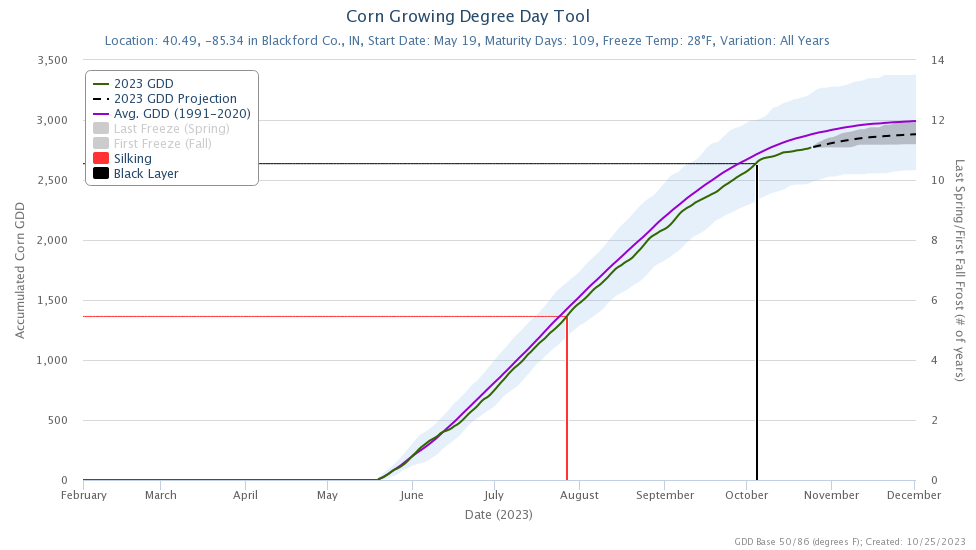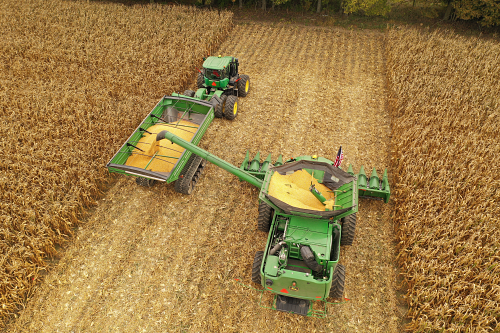
Fig. 1. GDD Accumulation Blackford Co 2023 for a 109-day relative maturity hybrid planted May 19th. Source: U2U - Corn GDD Tool (https://mygeohub.org/groups/u2u/purdue_gdd)

Some scuttlebutt down at the Chat 'n Chew Cafe suggests both the slow maturation and drydown in the field this fall were caused by all those smoky hazey days back in early to mid-summer, courtesy of the wild fires in parts of Canada. I don't buy into that theory. While it may be true that smoky haze (or cloudy haze for that matter) influences plant photosynthesis (and thus potentially grain yield), it does not DIRECTLY influence the rate of plant development (i.e., how fast plants mature).
Rather, it is primarily temperature that drives the rate of plant development (Nielsen, 2020). The warmer it is, the faster corn progresses through its growth stages. The cooler it is, the more slowly corn progresses. The smoky days may have INDIRECTLY contributed to the slower maturity if they contributed to cooler temperatures. However even if that was true, the cooler temperatures did not occur ONLY on those smoky days.
The climatological evidence suggests that the 2023 growing season was generally cooler than normal throughout and not just due to smoky days. The accompanying chart comes from the GDD Corn Tool developed by the "Useful to Useable" USDA-funded project (https://mygeohub.org/groups/u2u/purdue_gdd). To create the chart, I chose Blackford Co. in eastcentral Indiana, a 109-day hybrid maturity, and a May 19th planting (background information for one of our on-farm sulfur trials that is still running about 30% grain moisture as of about Oct. 23rd). The GDD Tool estimated that black layer did not occur until Oct 4th, which was exactly what our cooperator told us happened.
Click image to view larger version in a popup window.
The upper, purple, line represents normal GDD accumulations for that location and the black line represents GDD accumulations this year. The chart illustrates the below normal GDD accumulations for this location throughout the season. Cooler temperatures in mid-June put us behind normal early on and then around mid-Aug cooler than normal temperatures again expanded that deviation further. Continued cooler than normal weather at this location since black layer development has further slowed the in-field drying of the grain.
Thomison (2017) stated... "Generally, it takes about 30 GDDs to lower grain moisture each point from 30% down to 25%. Drying from 25 to 20 percent requires about 45 GDDs per point of moisture." The GDD accumulation for this location tends to support that statement if one makes an assumption that grain moisture at kernel black layer was a little higher than normal to begin with, say about 35%. Between Oct. 4th (black layer) and Oct. 23rd at this location, GDD accumulation was about 150. That total divided by 30 equals "5", meaning one would expect grain moisture on Oct. 23rd to be about 5 points drier, or about 30%, which is exactly what our cooperator told us it was running.
The bottom line that one can derive from the preceding rambling thoughts is that the slow grain drydown in parts of Indiana in 2023 is primarily due to a combination of later than desired planting plus cooler than normal temperatures throughout the whole season and not due to the relatively few number of smoky hazey days we experienced. In fact, about 50% of Indiana's corn crop in 2023 was planted after mid-May so it may not be surprising that so many farmers are complaining about this issue.
Jeschke, Mark. 2023. Is Smoke from Wildfires Affecting Crop Yields? Pioneer Agronomy, Corteva AgriScience. https://www.pioneer.com/us/agronomy/wildfires-crop-yields.html [accessed Oct 2023].
Nielsen, R.L. (Bob). 2018. Field Drydown of Mature Corn Grain. Corny News Network, Purdue Univ. Extension. https://www.agry.purdue.edu/ext/corn/news/timeless/GrainDrying.html [accessed Oct 2023].
Nielsen, R.L. (Bob). 2020. Heat Unit Concepts Related to Corn Development. Corny News Network, Purdue Univ. Extension. https://www.agry.purdue.edu/ext/corn/news/timeless/HeatUnits.html [accessed Oct 2023].
Quinn, Dan. 2023. How Does Wildfire Smoke Impact Corn Growth? The Kernel, Purdue Univ. Extension. https://ag.purdue.edu/news/department/agry/kernel-news/2023/07/2023-corn-wildfire-smoke.html [accessed Oct 2023].
Thomison, Peter. 2017. Cool Weather and Corn Dry Down. C.O.R.N. Newsletter, Agronomic Crops Network, Ohio State Univ. Extension. https://agcrops.osu.edu/newsletter/corn-newsletter/2017-30/cool-weather-and-corn-dry-down [accessed Oct 2023].
U2U Decision Support Tools - Corn GDD Tool. 2023. Useful to Useable Project. https://mygeohub.org/groups/u2u/purdue_gdd [accessed Oct 2023].